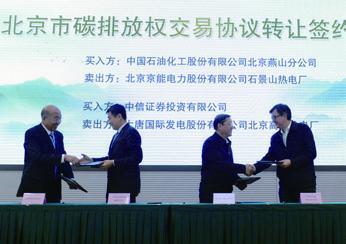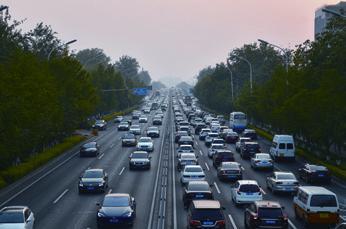Balancing Twin Goals
By Liu Minquan
Like many other countries, China suffered serious environment degradation in the early stages of its industrialization when its rapid economic growth came at a huge cost to its natural resources and the environment. However, in the past two to three decades, there has been a significant reversal of that trend, thanks to a wide range of government policies and peoples growing awareness of the need to protect the environment they work and live in.

A historical problem
While investigating the causes of environmental pollutions and ecosystem degradations in China, most analysts have focused on industrialization in the modern era. However, the root causes stretch back for centuries. In Chinas history, there were periods when the environment was overexploited in unsustainable ways, often bringing about famines and natural disasters.
Since the founding of the Peoples Republic of China (PRC) in 1949, industrialization and the accompanying urbanization have been the key drivers of environment deterioration. Both processes have placed severe and geographically concentrated pressures on the environment and natural resources, with serious effects on local ecosystems.
Also, beginning in 1978 and especially after Chinas accession into the World Trade Organization in 2001, China shifted to an export-oriented growth model, which has eventually made it the de facto factory of the world. While industrialization and economic development accelerated, they caused huge increase in harmful emissions.
The rapid pace of urbanization also exacerbated pollution levels. While only 11 percent of Chinas population lived in urban areas in 1950, 61 percent did so in 2019. In absolute terms, the urban population increased around 20-fold over the period.
The high rate of urbanization increased energy demands to power the new urban centers. A case in point is travel and transport. Over the past 20 years, car ownership in China has increased dramatically. While there were only 16 million motor vehicles on the road in 2000, the number increased to 232 million in 2018—a 15-fold rise.
Due to these and other factors, Chinas environmental and ecosystem problems in recent years have been serious and diverse. A high proportion of its natural resources such as water have been tainted by pollution. In turn, polluted resources have infl icted serious costs on the economy and human health.
Striking a balance
China began to formulate and establish an environmental protection policy program and related institutions in the early 1970s. In 1972, it sent representatives to the First United Nations Conference on the Human Environment in Sweden. The next year saw the first set of environmental regulations and surveillances, followed by the establishment of the Environment Protection Leading Group of the State Council in 1974.
A law on environmental protection was passed in 1979 for trial implementation, with the final law adopted 10 years later and a revision approved in 2014. In between these dates, a series of laws targeting specific areas of environmental protection were introduced, covering a wide range, from air pollution and solid waste to environmental impact assessment and renewable energy.
In 1982, the government began to charge polluting companies for their pollutant discharge and specific charges against sulfur dioxide emissions were adopted in 1992. The year 2016 saw the passage of a specifi c law on environmental taxes.
Organizationally, an environment protection bureau was set up in 1982 under the then Ministry of Urban and Rural Construction and Environmental Protection. In 2018, after various changes that elevated its status, it became the Ministry of Ecology and Environment with an enlarged portfolio.
In terms of policy programs, China adopted command-and-control measures in some cases and market-based ones in others. A good example of the former was the program implemented in 1998 to control sulfur dioxide emissions and acid rains. Nationally, 175 prefectural jurisdictions from 27 provinces became part of the control zones. Since 2006, China has set up mandatory targets for reduction of major pollutants such as sulfur dioxide.
A notable case of market-based measures is Chinas decision to join the international Clean Development Mechanism(CDM) at the turn of the century. The program was set up under the 1997 Kyoto Protocol on carbon emission. Under it, developed countries were assigned emission ceilings while developing countries were not. Countries with a ceiling could top up their emission limits by investing in countries without one to help cut emissions there. Chinas fi rst project under the program was registered in 2005.
According to a recent Peking University study, between Chinas fi rst CDM project and the end of 2012, a total of 3,764 projects were recorded, indicating the scale of involvement by Chinese enterprises. In 2011, drawing on the success achieved under the international trading program, China introduced its own experimental national carbon emission rights trading program with five municipalities and two provinces, operating more or less on the same principles as the international scheme.
Subsequently in 2017, nationwide carbon emission trading was opened for the electricity generating sector. By the end of 2018, the equivalent of 264 million tons of carbon dioxide had been traded.

Green gains
In recent years, Chinas overall environment quality has improved though the economy continues to grow and energy consumption continues to rise. Since 2013, the country has issued action plans against air, water and soil erosion, putting environment protection at high priority.
The stringent environment policies have produced effect. From 2013 to 2018, Chinas GDP increased by 39 percent while energy consumption and vehicle ownership increased respectively by 11 percent and 83 percent. During the period, the average concentration of PM2.5, fi ne particulate matters, and sulfur dioxide in 74 cities that fi rst implemented new ambient air quality standard decreased by 42 percent and 68 percent respectively, according to a report released by the National Bureau of Statistics in June 2019.
Also, Chinas carbon dioxide emissions per unit of GDP were cut by 45.8 percent from 2005 to 2018.
Moreover, a study carried out by Zhang Lingyu of Peking University in 2020 found that the command-and-control and market-based programs promoted green innovation.
The study reported a reduction in energy intensity and an increase in energy efficiency in production, as well as an average increase of 18.64 percent in the level of green innova- tions in the sulfur dioxide and acid rain control program counties. The effect on innovation was especially noticeable in high energy-intensity sectors.
The positive effect on the level of innovation in the CDM project areas, especially green innovations, was reflected by the rise in the number of patents obtained at the prefectural level where an international CDM project was implemented.
Since a disproportionately high share of the CDM projects was located in the central and western regions, where economic development and clean production lag behind other regions, the participation in the CDM program is considered to have a positive effect of reducing regional disparity.
While a national system of carbon emission right trading is still being fashioned, preliminary analyses show its positive effect in raising the number of patents won by the listed participating manufacturing firms by 20.33 percent, accompanied by an increase in their level of spending on research and development by 17.73 percent, the study shows.
These cases indicate that the twin goals of promoting economic development and protecting the environment can be achieved simultaneously.

